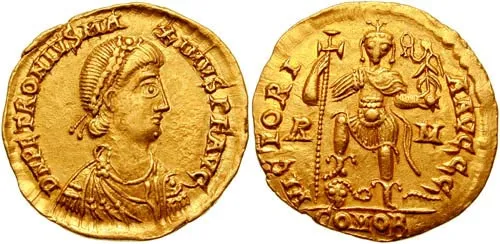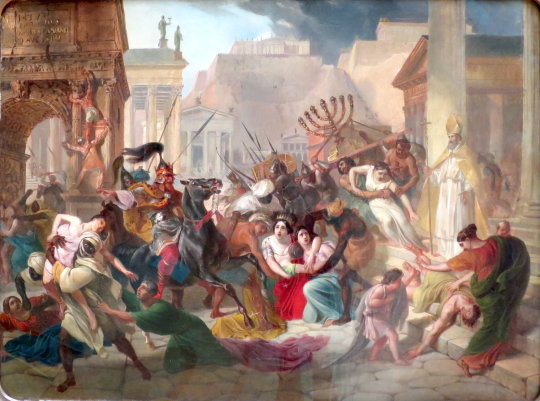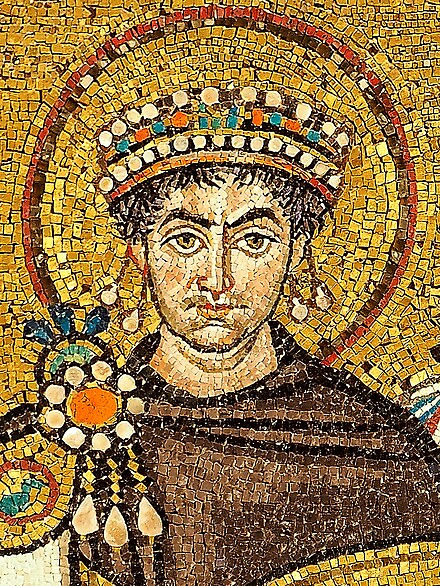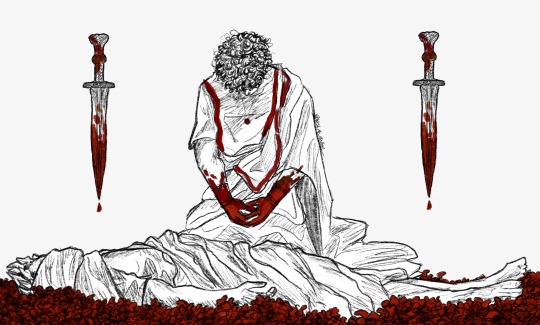#Late Roman Empire
Explore tagged Tumblr posts
Text

The so-called "Diptych of Honorius," made by an unknown artist for the Roman nobleman Anicius Petronius Probus to honor his consulship in 406 AD/CE. The left panel depicts Honorius, then ruler of the Western Roman Empire, in military garb. In his right hand, Honorius holds a standard that reads IN NOMINE CHRI(STI) VINCAS SEMPER ("May you always conquer in the name of Christ"). In his left hand is a globe surmounted by a figure of Victory, representing his claim to universal rule. The right panel depicts Probus himself, likewise in military garb and holding a staff. This diptych is now in the Museo del tesoro della cattedrale di Aosta, Italy. Photo credit: Dea Picture Library/Wikimedia Commons.
#classics#tagamemnon#history#ancient history#Ancient Rome#Roman Empire#Late Roman Empire#late antiquity#Roman history#Honorius#art#art history#ancient art#Roman art#Ancient Roman art#Late Roman art#late antique art#diptych#ivory#sculpture#portrait sculpture#Museo del tesoro della cattedrale di Aosta
270 notes
·
View notes
Text


Petronius Maximus --- The dipshit Roman emperor who caused the sack of Rome because he was an arrogant dipshit.
Petronius Maximus was a wealthy Roman politician born in 397 AD to old Roman money. Like many wealthy Romans he went into politics and throughout the early 5th century climbed the ranks of Roman government until he became one of the most powerful men in the Western Roman Empire. He was crafty and he was ambitious. He was also a dipshit and an asshole.
By the 450's P. Maximus had a clear plan, to create a power vacuum in Rome that he could cunningly fill. He began by turning the emperor at the time, Valentinian III, against his magister militum Flavius Aetius. As magister militum Aetius was commander of the Roman Army, and had proven himself a master tactician and brilliant diplomat. Through military victories and diplomacy Aetius was barely holding a crumbling empire together. Maximus convinced Valentinian III that Aetius was looking to usurp his throne. Thus in 454 Valentinian summoned Aetius to his palace and personally murdered him with his sword. Maximus had organized the death of the most talented Roman official in the empire, which in the grand scheme of things was probably a big mistake. With Aetius dead, Maximus expected he would take Aetius' place as magister militum. However Valentinian refused to appoint him as magister militum. Thus in 455 AD, Maximus had him assassinated, hiring two of Aetius' bodyguards to do the deed as revenge.
Several powerful Romans claimed the Imperial throne but Maximus managed to beat them all to the punch by taking over the Imperial Palace and immediately marrying Valentinian's widow, Licinia Eudoxia. Licinia didn't know Maximus had murdered her husband at the time but had suspicions. He also forced her daughters, Placidia and Eudocia to marry his sons. Through deceit and murder Maximus had managed to weasel his way into the Roman Imperial family and was now creating his own Imperial dynasty. Thus Petronius Maximus had become Emperor Dipshit, ruler of the shiny turd of what was left of the Western Roman Empire.
Problem was, when Emperor Dipshit married off Placidia and Eudocia to his sons, he canceled Eudocia's arranged marriage to Hunneric, who was the son of Geiseric, king of the Vandals. The Vandals were a Germanic tribe that had set up a prosperous kingdom in the former Roman province of North Africa, and were constantly raiding the Italian coast. Valentinian had arranged the marriage of Eudocia as a peace offering to Geiseric. Geiseric had received a letter from Eudoxia informing him that Maximus had killed her husband and was canceling the marriage of Eudocia. Geiseric was enraged at Empror Dipshit for canceling the marriage, and sent a Vandal fleet and army to Rome in response. "No problem" said Emperor Dipshit, "we got the Roman Army".
Except there was no Roman Army. Not really. After the death of Aetius the remains of the standing full time professional army had collapsed almost completely. Even Aetius was very dependent on mercenaries and allies. Nobody wanted to enlist in the Roman Army in the 5th century, with Romans going so far as to cut off their own fingers to avoid conscription. The Roman economy was a mess, the Imperial bureaucracy was riddled with corruption, the life of the average Roman was miserable, and by the 5th century most Roman emperors were snobbish, over-privileged, incompetent out of touch dipshits. The empire was dying and everybody knew it. Few believed it was worth saving, and nobody wanted to die for a dipshit emperor such as Emperor Dipshit. By 455 AD what was left of the Roman Army consisted of militia units called "limitanei" who acted as border patrolmen far away from Rome. For more complex military operations the Romans were fully dependent on mercenaries and allies. Emperor Dipshit attempted to enlist the help of the Visigoths, but they were like, "LMFAO nooo, you made your bed now lie in it!" I speculate they knew Maximus was a dipshit who was probably gonna get them all killed.
Emperor Dipshit knew it was a hopeless situation, so he made an announcement to the Roman people to flee and save themselves, then he too turned tail and fled. He was spotted by a large group of Roman refugees, who formed a mob and beat him to death. Good riddance. Emperor Dipshit's glorious reign lasted 77 days.
As far as sackings go the sack of Rome in 455 AD wasn't too bad. The Vandals were Christians, so the Pope was able to convince them not to do the more horrible things like rape and murder civilians, or burn down the city. So for the most part the Vandals refrained from bloodshed and arson. However they did take as many Romans into slavery as they could fit on their ships, and they also looted the city of almost everything of value. Even the bronze tiles on the roof of the Temple of Jupiter were pried off and carted away. Also Geiseric carted off Eudocia and married her off to his son Huneric.
The Vandal's sack of Rome in 455 is where we get the term "vandalism" today. Also did I mention that Petronius Maximus was a dipshit?
#history#ancient history#ancient rome#dipshit#fall of rome#vandals#roman empire#western roman empire#late roman empire
226 notes
·
View notes
Note
How did people become serfs? Like, birth was probably the answer for some, but were other people made serfs after being born in a different social class? And how did it get started, anyway?
Given that the legal default in medieval society was that you were born into the legal status of your (usually male) parent and could not change it, most serfs post the first generation were born serfs.
But as I was suggesting in my post about the Normans, you could be made into a serf through a change to the underlying land tenure that defined your legal status. So for example, you could start out a free churl (wasn't initially a pejorative, but there is something insidious about the way that words for working people get transformed into insults), and then 1066 rolls around.
All of the sudden some collaborator translator is explaining to you what some French-speaking foreign priest is saying about how the new king's new legal system doesn't recognize "churl" as a valid status, please tick the box for either "knight" or "serf," and if you complain there's this French-speaking illiterate violent maniac on horseback backing him up - and the maniac thinks he owns the land your father's bones are buried in and you and your family come with the land, and he'll kill you if you disagree or if he gets bored.

As to how it got started...arguably it all goes back to Diocletian. As a reforming Roman Emperor in the Crisis of the Third Century, Diocletian was having trouble getting his hands on enough hard cash to pay the troops who guarded the borders (who were increasingly led by men with titles that would be later translated as Duke, Count, and Baron, which is a bad sign), so he started paying them in-kind and extracting taxes from the coloni (tenant farmers) in-kind. In order to ensure that revenue from the coloni remained consistent, Diocletian issued an edict that it was illegal for the child of a coloni to hold any other occupation than coloni, and that it was illegal for coloni to leave the land upon which they farmed.
Pretty soon, once the Emperor goes away and there's only the Duke, the Count, and the Baron running the show, the local warlord just cuts out the middle-man and takes the in-kind taxes directly, calls them rent, and asserts that they own the land (or at least the right to rents and taxes from the land) while menacingly sharpening a sword. And hey presto, you've got serfdom!
224 notes
·
View notes
Text
Empress Theodora entering Hagia Soph..
oh wait, it's Alicent.

#byzantine#byzantium#game of thrones#house of the dragon#hotd#alicent hightower#rhaenyra targaryen#daemon targaryen#hagia sophia#constantinople#roman empire#late roman empire#late antiquity#house targaryen#team green#team black#hbo#hbo max#theodora#justinian#empress
28 notes
·
View notes
Text
youtube
What would have happened if the Roman emperor Flavius Julian, better known as Julian the Apostate for renouncing Christianity in favor of Paganism, had decided not to invade Persia, a conflict in which he was killed, and instead dedicated himself to his project to restore the old religion and reform the Empire?
2 notes
·
View notes
Text
FLAVIVS AETIVS
SERVA ME
SALVM ME FAC AETIVS
im gonna be real everypony, the Visigoths are sacking Rome.
2K notes
·
View notes
Text
youtube
Meet the most evil psychopath of the late Western Roman Empire: Ricimer.
0 notes
Text
SPA: La Anunciación en un fragmento de lino encontrado en una tumba en Akhmim (Egipto), quizá parte de una cortina (siglos IV-V d.C). A la izquierda se ve a la Virgen María hilando con su rueca, huso y cesta, mostrándola como ejemplo de la perfecta mujer virtuosa en la Tardoantigüedad cristiana, siguiendo el modelo de la matrona romana anterior.
ENG: The Annunciation on a linen fragment found in a tomb at Akhmim (Egypt), perhaps part of a curtain (4th-5th centuries AD). On the left the Virgin Mary is seen spinning with her spinning wheel, spindle and basket, showing her as an example of the perfect virtuous woman in late Christian antiquity, following the model of the earlier Roman matron.

Victoria and Albert Museum
#historia textil#historical textile#ancient history#historicalclothing#textiles#spinning#virgin mary#late roman empire
1 note
·
View note
Text
The sentence "hotly debated, with disagreement even among pottery experts" just tickles me a little
1 note
·
View note
Text

Mosaic fragment, ca. 400 CE, from Roman Syria, depicting a peacock. Now in the Kimbell Art Museum, Fort Worth, TX, USA.
#classics#tagamemnon#history#ancient history#Ancient Rome#Roman Empire#Late Roman Empire#late antiquity#art#art history#ancient art#Roman art#Ancient Roman art#Roman Imperial art#Late Roman art#late antique art#mosaic#animals in art#peacock#peacocks#Kimbell Art Museum
176 notes
·
View notes
Text
The late Roman Empire as referred to here is a specific history and snapshot of the reigns of Roman Emperors from Diocletian to Theodosius I. In this era the Roman Empire adopted the Christian religion, which provided new social phenomena and redefinitions of power and prestige that included in the form of Bishop Ambrose and the Emperor Theodosius's clashes the first preludes to the great medieval Emperor-Church strife in the West and its more muted equivalents in the East.
This is one of the works that does not in actual fact reach to the actual collapse of the Western Empire, though it notes that speaking of the decline of the broader state requires asking why the Byzantine/Eastern half not only withstood the crisis but was able to make the conquests of Justinian and Basil Bulgaroktonos, among others. This is also, incidentally, why ye olde climate change cannot be held to cause the collapse of the Empire as that would indicate the artificial lines chosen between East and West put a force field around the Eastern Empire while only affecting the West. Climate doesn't work that way.
Too, this work raises the important point that the Ancient world had sweeping visions but less than efficient means to ensure they actually happened which one might note also applies to the great Indian and Chinese Empires, as well as the Central Asian states like Bactria and the Kushan Empire. So while the Christian Emperors aspired to a totalitarian vision to sweep away centuries and millennia of older ideas and values the reality was very different and more complicated, and this in turn would evolve further under the early medieval Germanic kingdoms in Western Europe and the surviving Eastern Empire in the Middle East, Africa, and Eastern Europe.
8/10.
#lightdancer comments on history#book reviews#late roman empire#constantinian dynasty#theodosian dynasty
0 notes
Note
What do you think of Justinian's reign as emperor? A new biography of him that gives fairly positive conclusions on his reign just came out at around the same time as Anthony Kaldelis new history of the byzantines which has a basically equally negative reading of the same subject.

An odd mix of extreme competence in many areas of governance, but so much of that energy was directed at an impossible and arguably counter-productive goal.
He should have stuck with North Africa and the Mediterranean islands so as to preserve his resources for the more important conflict with Khosrau of Persia, rather than waste blood and treasure trying to conquer an empty Rome.
38 notes
·
View notes
Text
Was it a Good Idea to Recruit Barbarians in the Late Roman Empire?
youtube
They often say the Western Roman Empire fell in no small part because barbarians replaced Romans in the army, but have you ever wondered why the Roman government did something so stupid?
0 notes
Text
youtube
The Forgotten Giant Disaster Of The Late Roman Empire.
0 notes
Text
What Constantine the Great had going on with the tetriarchy was truly the highest form of family drama
1 note
·
View note
Text

This was such a pain to draw goodnight
423 notes
·
View notes